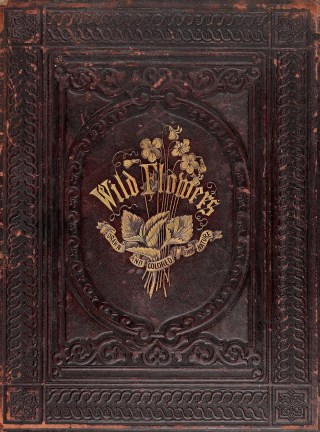A vibrant celebration of flowers as “brilliant hopes, all woven in gorgeous tissues,” as “stars… wherein we read our history.”
“To be a flower,” Emily Dickinson wrote in her prescient ode to the interconnectedness of nature, “is profound responsibility.”
A passionate lifelong gardener, the poet had fallen under the spell of wildflowers while composing her astonishing herbarium as a teenager. But it was an uncommonly beautiful book her father gave her just before she turned thirty — not long after she wrote to an ill-suited suitor, “My flowers don’t know how far my thoughts wander away sometimes.” — that fueled her poetic passion for nature’s own garden: Wild Flowers Drawn and Colored from Nature (public library) by the botanical artist and poet Clarissa Munger Badger (May 20, 1806–December 14, 1889).
Wildflowers by Clarissa Munger Badger. (Available as a print and as stationery cards, benefitting The Nature Conservancy.)Violets by Clarissa Munger Badger. (Available as a print and as stationery cards, benefitting The Nature Conservancy.)Wood lily by Clarissa Munger Badger. (Available as a print and as stationery cards, benefitting The Nature Conservancy.)
Published the year On the Origin of Species shook science and artistically modeled on The Moral of Flowers, with which the poet and painter Rebecca Hey had enchanted English readers a quarter century earlier, Badger’s book contained twenty-two exquisite scientifically accurate paintings of common New England wildflower species — violets and harebells, the rhododendron and the honeysuckle — each paired with a poem bridging the botanical and the existential: some by titans like Percival and Longfellow, some by long-forgotten poets of her time and place, some by Badger herself.
Poertrait of Clarissa Munger Badger, painted by Nathaniel Jocelyn in 1847 — the year Emily Dickinson’s only known photographic portrait was taken.Wildflowers by Clarissa Munger Badger. (Available as a print and as stationery cards, benefitting The Nature Conservancy.)Harebell by Clarissa Munger Badger. (Available as a print and as stationery cards, benefitting The Nature Conservancy.)Rhododendron by Clarissa Munger Badger. (Available as a print and as stationery cards, benefitting The Nature Conservancy.)
For a taste of her fusion of playfulness and poignancy, here is a fragment from Badger’s ode to the rhododendron — a flowering wonder that was here when the dinosaurs roamed Earth, long before small warm-blooded mammals with large minds and poetic hearts evolved the opposable the thumbs to paint flowers and the consciousness to contemplate the meaning of life in a flower:
I charge thee, flower, of beauty born,
Lift not thy head too high,
For, like the lowliest of thy race,
Thou, too, wert born to die.
The Power that lifts thee to the sun,
And bends thee to the gale,
Doth watch, with equal care and love,
The Lily of the vale.
Wildflowers by Clarissa Munger Badger. (Available as a print and as stationery cards, benefitting The Nature Conservancy.)Cardinal flower by Clarissa Munger Badger. (Available as a print and as stationery cards, benefitting The Nature Conservancy.)Fringed gentian by Clarissa Munger Badger. (Available as a print and as stationery cards, benefitting The Nature Conservancy.)Red maple by Clarissa Munger Badger. (Available as a print and as stationery cards, benefitting The Nature Conservancy.)Wild rose by Clarissa Munger Badger. (Available as a print and as stationery cards, benefitting The Nature Conservancy.)Wild honeysuckle by Clarissa Munger Badger. (Available as a print and as stationery cards, benefitting The Nature Conservancy.)Wild Columbine by Clarissa Munger Badger. (Available as a print and as stationery cards, benefitting The Nature Conservancy.)Beauty-berry by Clarissa Munger Badger. (Available as a print and as stationery cards, benefitting The Nature Conservancy.)Yellow lily by Clarissa Munger Badger. (Available as a print and as stationery cards, benefitting The Nature Conservancy.)Sweet-brier by Clarissa Munger Badger. (Available as a print and as stationery cards, benefitting The Nature Conservancy.)Tulip-tree blossom by Clarissa Munger Badger. (Available as a print and as stationery cards, benefitting The Nature Conservancy.)Fringed Orchis by Clarissa Munger Badger. (Available as a print and as stationery cards, benefitting The Nature Conservancy.)
Seven years later, as Bronson Alcott was contemplating the relationship between gardening and genius while raising his visionary daughter a state over in New England and Ernst Haeckel was coining the word ecology, Clarissa Munger Badger gave her wildflower masterpiece a domestic counterpart in Floral Belles from the Green-House and Garden (public library | public domain).
Bringing her brush to the beauty of the pansy and the lily, the day-blazing geranium and the night-blooming cactus, the tulip and the rose, and once again pairing her paintings with poems, she celebrated garden flowers as “brilliant hopes, all woven in gorgeous tissues,” as “stars… wherein we read our history” — a vibrant testament to Oliver Sacks’s clinically substantiated belief in the healing power of gardens.
Tulips by Clarissa Munger Badger. (Available as a print and as stationery cards, benefitting The Nature Conservancy.)Calla lily and poincettia by Clarissa Munger Badger. (Available as a print and as stationery cards, benefitting The Nature Conservancy.)Larkspur and Japan lily by Clarissa Munger Badger. (Available as a print and as stationery cards, benefitting The Nature Conservancy.)Passion-flower by Clarissa Munger Badger. (Available as a print and as stationery cards, benefitting The Nature Conservancy.)Salvia and dielytra by Clarissa Munger Badger. (Available as a print and as stationery cards, benefitting The Nature Conservancy.)Cactus bloom by Clarissa Munger Badger. (Available as a print and as stationery cards, benefitting The Nature Conservancy.)Fuchsia by Clarissa Munger Badger. (Available as a print and as stationery cards, benefitting The Nature Conservancy.)Geranium by Clarissa Munger Badger. (Available as a print and as stationery cards, benefitting The Nature Conservancy.)Pansies by Clarissa Munger Badger. (Available as a print and as stationery cards, benefitting The Nature Conservancy.)Moss rose by Clarissa Munger Badger. (Available as a print and as stationery cards, benefitting The Nature Conservancy.)Rose of Gethsemane by Clarissa Munger Badger. (Available as a print and as stationery cards, benefitting The Nature Conservancy.)Aster by Clarissa Munger Badger. (Available as a print and as stationery cards, benefitting The Nature Conservancy.)Night-blooming cereus cactus by Clarissa Munger Badger. (Available as a print and as stationery cards, benefitting The Nature Conservancy.)Flowers by Clarissa Munger Badger. (Available as a print and as stationery cards, benefitting The Nature Conservancy.)
Couple with these stunning French botanical drawings of some of Earth’s most otherworldly plants from Badger’s epoch, then leap forward a century with pioneering plant ecologist Edith Clements’s Rocky Mountain wildflower drawings, then leap back two with the self-taught artist and botanist Elizabeth Blackwell’s gorgeous illustrations from the world’s first pictorial encyclopedia of medicinal plants, then straddle the centuries with this layered reflection on flowers and the meaning of life, starring Emily Dickinson and The Little Prince, then slake your soul on this.
donating = loving
For a decade and half, I have been spending hundreds of hours and thousands of dollars each month composing The Marginalian (which bore the unbearable name Brain Pickings for its first fifteen years). It has remained free and ad-free and alive thanks to patronage from readers. I have no staff, no interns, no assistant — a thoroughly one-woman labor of love that is also my life and my livelihood. If this labor makes your own life more livable in any way, please consider lending a helping hand with a donation. Your support makes all the difference.
newsletter
The Marginalian has a free weekly newsletter. It comes out on Sundays and offers the week’s most inspiring reading. Here’s what to expect. Like? Sign up.





